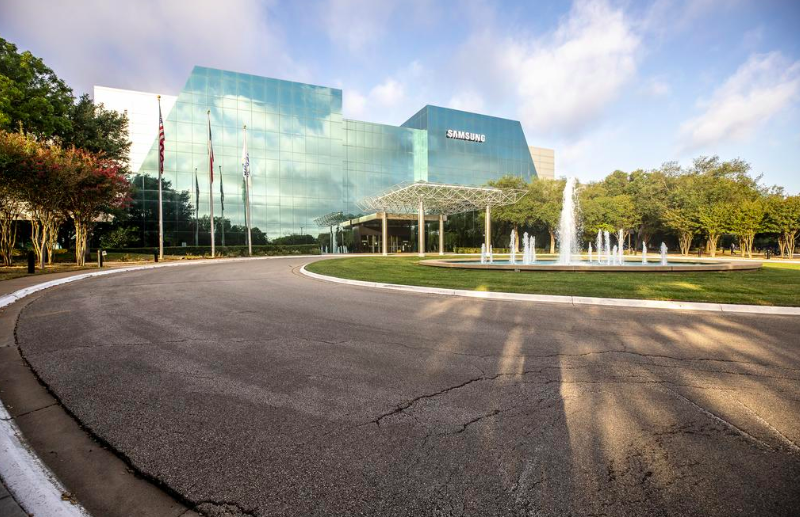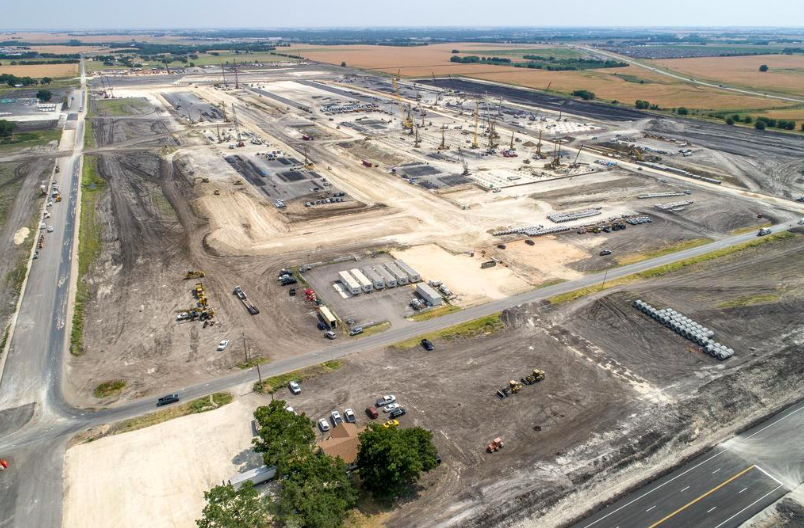When Taylor Mayor Brandt Rydell found out that Samsung Electronics Co. Ltd. could expand even further in his city, beyond the $17 billion factory it had already pledged, he was speechless.
Ever since the South Korean technology giant announced last year it would build a chipmaking plant in the city and create 2,000 jobs, there has been speculation the company would bring more development to the 1,270-acre plot it owns in the small city northeast of Austin.
But just how much more investment was the company considering? That became public July 20: Samsung could build nine semiconductor fabrication plants, or fabs; invest $167 billion over the next two decades and create around 8,200 jobs — in a city with a population of about 17,000.
“I still haven’t gotten my mind around what a $17 billion investment means for Taylor. To me that was already borderline unfathomable just in terms of the scale of that project and what it means for not just Taylor [but also] the region,” he said. “With now this news that the potential expansion could include up to nine fabs and $167.4 billion … that’s like trying to consider the limits of the universe to me.”

The new details came to light in incentives applications. There is no guarantee the company follows through on these additional developments, and a Samsung executive said it does not have “specific plans to build at this time.”
“The Chapter 313 applications to the State of Texas are part of a long-term planning process of Samsung to evaluate the viability of potentially building additional fabrication plants in the United States,” Michele Glaze, director of communications at Samsung Austin Semiconductor LLC, said in a statement.
In addition to new development in Taylor, Samsung said it could build two more fabs at its longstanding manufacturing campus in Northeast Austin. That would be an investment of $24.5 billion that creates 1,800 jobs.
In total, Samsung said it could invest $192.1 billion in Central Texas and create at least 10,000 jobs in the coming decades. To put that into perspective, Tesla’s new Austin Gigafactory has been put up as a roughly $1.1 billion initial investment. Semiconductor plants have such high price tags partly because of the expensive and highly specialized equipment inside of them.
If fully realized, the Samsung proposals could amount to the largest economic development project in the country’s history. And combined with the initial Taylor factory, the South Korean company could ultimately have 12 additional plants totaling more than $200 billion in investment in the Austin area by 2042.

The incentives filings came ahead of a deadline to submit for tax breaks through the state’s Chapter 313 program, which is sunsetting at the end of the year.
Just the possibility of the expansion spurred regional and state leaders to weigh in on a project that could cause ripples in the local economy for generations to come and fortify the United Stats as a self-sufficient source of computer chips.
Gov. Greg Abbott, who last year hosted the announcement for the first 6-million-square-foot factory in Taylor, said additional investment would solidify Texas as “the nation’s leader in the semiconductor industry.”
“Close partnerships with companies like Samsung — who recognize the boundless possibilities Texas has to offer — are bringing greater opportunities to Texans, and this potential investment will bring billions of additional capital to continue growing our world-class business climate and diverse, highly-skilled workforce,” he said in a statement.
Williamson County Judge Bill Gravell, who along with Rydell and Williamson County Commissioner Russ Boles was instrumental in initially bringing the project to Taylor, said he was excited about what the agreements could mean for the children of Taylor and the school district.
“I am excited about Samsung’s potential expansion in the region that could exceed $184 billion in Williamson County. Our working relationship is strong and our future is bright. We are grateful to Samsung for partnering with us to be a leader in the technology industry as the home to potentially the largest semiconductor facility in the world. We are proud to provide this critical infrastructure for national security by producing semiconductors here in the United States,” he said in a statement.
Others championed the regional economic benefit.
“Samsung continues to demonstrate its commitment to Central Texas and we are grateful for their tremendous investment in this region. We are also excited about the benefit to Central Texas from the ancillary growth and jobs that will accompany Samsung’s investment,” said Laura Huffman, president and CEO of the Austin Chamber of Commerce.
Mixed reaction to incentives
Samsung is asking Taylor Independent School District for Chapter 313 incentives, which allow school districts to limit the taxable value of a property for a portion of school taxes. The Chapter 313 program allows a cap of $10 million to $100 million for up to 10 years. The program is scheduled to sunset at the end of the year and manufacturers have been filing applications to lock incentives in before then.
Samsung is seeking to place an $80 million cap on the value of the land for maintenance and operations school taxes. This is just the application stage; no deals have been finalized and the incentives details are still subject to negotiations.
But if Samsung is ultimately approved for all of the incentives agreements, and the projects proceed as described, the company could save nearly $4.8 billion on its property taxes over the course of the agreements, based on an Austin Business Journal analysis of the applications. That’s according to projections of land values far into the future, so it’s a rough estimation, but it offers an idea of the immense value of the incentives.
Tax savings of almost $4.8 billion would represent the largest incentives awarded to any company in Texas, according to data from Good Jobs First, a Washington, D.C.-based nonprofit tracking corporate subsidies around the nation.
The $17 billion Samsung factory rising in Taylor already secured incentives worth a combined $1.19 billion across multiple agreements with the city, county and school district.
Taylor ISD Superintendent Devin Padavil said they’ll “be ready to share more later in the year.”
“We are excited about the future of Taylor, Texas for our students because of economic developments such as this,” he said.
The Chapter 313 program is controversial, especially because it affects public school funding.
Bringing it home
Austin Mayor Steve Adler said the proposals represent “the upside potential of what Samsung could mean to the region.”
“It will be interesting to see how it plays out,” he said. “It is just great to hear that they are thinking that the size of expansion is even in the realm of possibility.”
Adler connected the proposals to regional needs like bringing in more high-paying jobs as Central Texas deals with escalating costs of living.
“It represents the middle-tech skill jobs and clean manufacturing which I think is Austin’s place,” he said. “It is the kind of ecological manufacturing that you want and it’s the tech jobs that don’t require a four-year degree, so it’s the kind of jobs that we need in this city.”
But perhaps no community stands to be impacted as much as Taylor, where Rydell was born and raised. A half-century ago, the city was a thriving hub of agricultural production in eastern Williamson County, but it largely missed out on the tech-fueled boom of the Austin metro in recent decades.
Rydell labeled the potential expansion as “just mind-boggling,” adding that it will be transformative for the city for generations to come.
“I don’t even know how to quantify if Samsung were to follow through on the full-scale of this expansion outlined in those documents, I’m not sure how you quantify the impact it will have on this community and the impact this will have for generations. Literally it makes me speechless,” he said.
A city as small as Taylor will be forced to grapple with an influx of new residents, and needs for additional infrastructure and housing. But Rydell said that’s something city leaders were preparing for with or without Samsung and that they have a few more years to manage the additional growth.
“Of course, those 10,000 employees aren’t necessarily guaranteed to be Taylor residents,” he said. “As Central Texas continues to grow, that presents a lot of challenges for all of us. But when you’re having to tackle challenges, it’s great to have opportunities like what may be the largest economic development in the country or the world. If this were to happen, I’m not sure there’s anything on the same scale than we’d see.”
The project has garnered some pushback, including last week at a Council meeting when some members voted against some changes to incentives agreements, cautioning that they were concerned about being asked to continually “give and give.”
But Rydell said the Council is aligned in that they are all in favor of the Samsung project, and that based on community feedback, the support largely outweighs the opposition — adding that he anticipates those voices growing louder as more development is promised.
“There are always a certain percentage of any community that is against something and certainly here in Taylor, with Samsung, there is a minority view that stands in opposition to this project even at the $17 billion level. I think they’re much more vocal in their opposition than even the widespread support of those who are so enthusiastic of Samsung being here,” he said.
As a result, his enthusiasm has not waned.
“Bright days are certainly ahead for Taylor and Samsung,” Rydell said.
The Article is from Austin Business Journal, copyright belongs to owner


